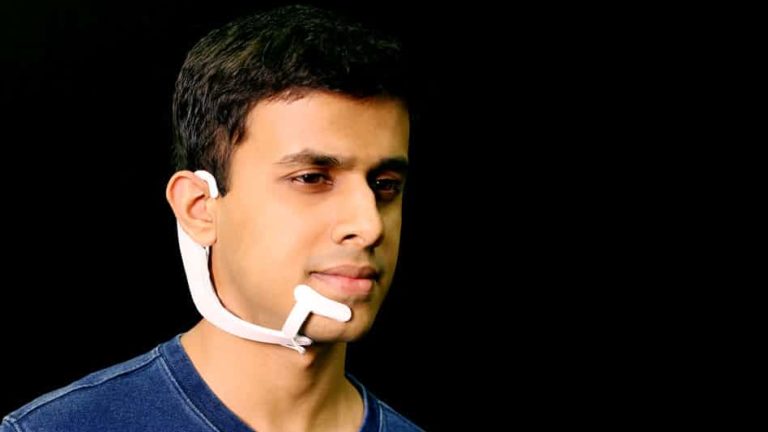Researchers Have Created a Device That Can Hear Your Inner Voice

MIT researchers have created a wearable device that can read your internal dialogue with 92 percent accuracy. The device allows users to ask questions and remotely control other devices without saying a word.
The device, called AlterEgo, resembles a jawbone hooking around the ear and attaching to the user’s face between the lip and chin. Using a bone conduction system, it can hear and respond to the wearer’s internal voice through electrodes attached to the skin.
Developed by a team at MIT’s Media Lab, the intention of the device is to seamlessly fuse humans and machines, soon allowing access one’s smartphone without having to physically manipulate it. Team leader, Arnav Kapur, described it as an attempt to develop a computing platform as “an internal extension of our own cognition,” and “intelligence augmentation.”
The device seems to be the first major step toward a transhumanist cognitive enhancement as technology increasingly becomes an extension of our bodies.
When we verbalize internally, we trigger subtle neuromuscular signals. AlterEgo can read these signals through electrodes placed on the skin. The device then responds to the wearer through a bone conduction speaker, eliminating the need for earbuds or headphones.
Bone conduction headphones are an existing technology that have gained popularity over the past few years, though the phenomenon is believed to have been discovered as far back as the 1500s.
In a video demonstrating AlterEgo’s capabilities, its designers claim that their goal is to combine humans and computers so that computing, the internet, and AI would weave into one’s personality to create a “second self.”
With just 15 minutes of customizing the device to an individual, AlterEgo can transcribe internal dialogue with 92 percent accuracy – human voice word accuracy is 95 percent on average. Kapur and his colleagues are working on improving the number of words the device can understand, saying eventually it will achieve full conversational capability.
Currently the device is only able to recognize 20 words and can respond to commands pertaining to chess, basic arithmetic, and simple television remote control functions.
But the technology is promising for future use in noisy and silent environments, as well as for people suffering from speech disabilities. The team will continue to develop the technology while also reducing the number of electrodes connected to the skin from seven to four.
Wilhelm Reich — Prophet or Madman?

“My present work began in the realm of psychiatry and psychoanalysis. This led to the discovery of bio-energy in the living organism and atmosphere. It follows new, hitherto unknown functional laws of nature.”
~ Wilhelm Reich
Born in Austria at the close of the 19th century, Wilhelm Reich was the son of a Jewish farmer but was deprived of his heritage by parents who raised their children as “Austrians’” a nationalistic, rather than religious, identity. After a complicated childhood and his parents’ deaths, young Reich joined the Austro-Hungarian army during WWI.
After the war, Reich enrolled in law school at the University of Vienna but switched to medical studies early on. At the time, a renaissance of inquiry into human nature was beginning. After attending a talk by Sigmund Freud, then a lecturer in neurology, Reich took a job at the Freud’s Vienna Ambulatorium, an experimental psychoanalytic clinic, soon earning the role of assistant director. Biographers have referred to Reich as Freud’s wunderkind or his prodigy.





































